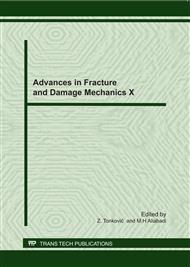p.702
p.706
p.710
p.714
p.718
p.722
p.727
p.731
p.735
Numerical Stress Intensity Factors Determination for Fabrication Defects in Coronary Stents
Abstract:
Objectives: Numerical stress intensity factors (SIFs) computation for several fabrication defect geometries in coronary stents. XFEM crack initiation and propagation was also performed. Methods: The model represents a self-expandable coronary stent, made from a shape memory alloy (L-605). Several flaw shapes are considered. The analysis was performed using the ABAQUS code. The loads and boundary conditions simulate the interaction between the blood vessels and stents, immediately after the angioplasty was performed. The mesh contains 3d stress hexahedral elements. For global stress and strain distributions, the model of a complete stent was used. For crack propagation analysis and SIF determination, the model represented a single segment of the stent. The stress intensity factors were computed using the contour integral method. Results and conclusions: The stress and strain fields highlight the negative effects of crack initiation and propagation on the residual life of the stent. Furthermore, by compromising the structural integrity of the stent, large strains may occur, thus increasing the risk of restenosis and further stenosis-related complications. The stress intensity factors indicate the most dangerous locations for the flaws (cracks), as well as the most dangerous geometries.
Info:
Periodical:
Pages:
718-721
Citation:
Online since:
September 2011
Keywords:
Price:
Сopyright:
© 2012 Trans Tech Publications Ltd. All Rights Reserved
Share:
Citation:


